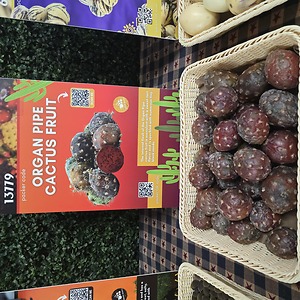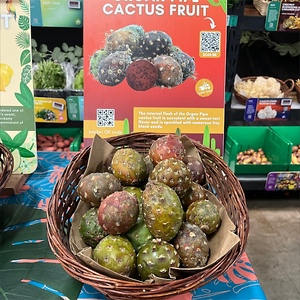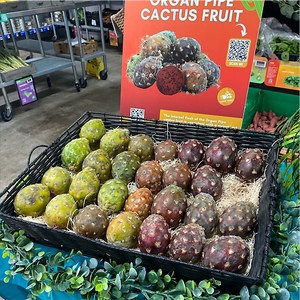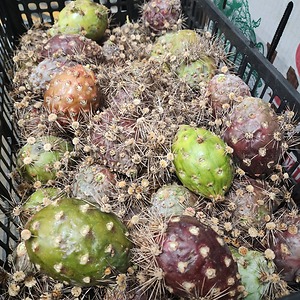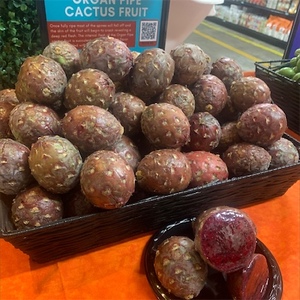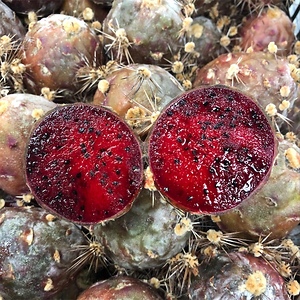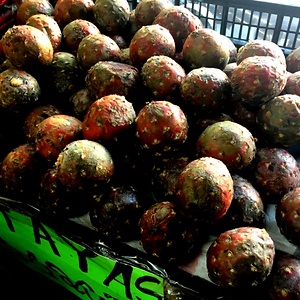


Organ Pipe Cactus Fruit
Estimated Inventory, lb : 0
This item was last sold on : 06/07/25
Description/Taste
Organ Pipe cactus fruit have a rounded shape and grow to be about the size of a tennis ball. The exterior of the fruit boasts a dusty rose hue and is often covered in splotches of pale yellow. Organ Pipe cactus stems and fruits also have clusters of sharp, spiky protrusions covering their exterior. These clusters provide protection and shade which helps to slow water loss from the cactus. Once fully ripe most of the spines will fall off and the skin of the fruit will begin to crack revealing a deep red flesh. The internal flesh of the Organ Pipe cactus fruit is succulent with a sweet-tart flavor and is speckled with numerous tiny black seeds.
Seasons/Availability
Organ Pipe cactus fruit is available in the late summer.
Current Facts
The Organ Pipe cactus, botanically known as part of Stenocereus thurberi, is a member of the Cactaceae family. The second largest cactus species in the United States, the Organ Pipe cactus can grow up to 24 feet in height and owes its modern name to early settlers who upon first encountering it associated its tall, upright growing branches with the musical instrument of the same name. The Organ Pipe cactus was originally and still today is known as well by the name Pitaya Dulce, Sweet Pitaya, or simply Pitaya (not to be confused with dragon fruit pitaya, another cactus fruit.) Today the bulk of Organ Pipe cacti in the United States are located in a protected monument region and as a result, the fruits are not as commonly consumed or sold. In Mexico, however, the cactus still grows wild, and when the fruits come into season, they are harvested to provide a source of food locally as well as a source of income as a crop sold at the markets.
Nutritional Value
Organ Pipe cactus has predominately been used as a source of calories and hydration in the desert regions where it has long been grown. Organ Pipe cactus fruit additionally offer some protein and essential oil compounds.
Applications
Before using Organ Pipe cactus fruit be sure to remove the outer skin carefully and make sure all the spines are removed. Organ Pipe cactus fruit can be eaten fresh cut into slices or simply peeled and enjoyed as is. The flesh can be pureed and incorporated into desserts such as sorbet and popsicles. Organ Pipe fruit can be blended and strained to make juice, cocktails, smoothies, wine, or agua fresca. The pureed flesh can also be used to make vibrant hued sauces and jellies or syrup for use in shaved ice. For best quality store Organ Pipe cactus fruit in a cool, dry location and use within a week of harvest.
Ethnic/Cultural Info
The fruit of the Organ Pipe cactus has long provided a source of calories for Native Americans in the southwestern United States and Mexico. The Pima and Papago tribes collected the fruits when ripe and would eat them fresh, ferment them to make wine, and dry the fruits to provide sustenance long past the hot summer fruiting season of the cactus. The seeds of the fruit were also dried and ground down to make flour for use in making seed cakes. Organ Pipe cactus fruit was also used medicinally, and the cactus stems used to build shelter and torches. The fruits were such a staple in the Papago diet that their name given for the Milky Way galaxy was “the second harvest of pitahaya.”
Geography/History
Organ Pipe cactus is native to the Baja California peninsula and the southwestern United States, specifically the Sonoran Desert region where it has been growing for over 3500 years. Today the bulk of Organ Pipe cactus in the United States can be found in the Organ Pipe Cactus National Monument. The monument not only provides an ideal location climate-wise for the cactus but also protects the cactus from extinction. In Mexico, the Organ Pipe cactus fruit is harvested freely though the species is becoming vulnerable as land where it has long been grown is increasingly being cleared for agricultural and shrimp aquaculture purposes. The Organ Pipe cactus has evolutionary traits which allow it to survive in the desert such as shallow roots which absorb rainfall quickly and spongy stems that are able to store water. The Organ Pipe cactus also only takes in carbon dioxide nocturnally which allows it to seal its skin during the day and prevent moisture loss.
Recipe Ideas
Recipes that include Organ Pipe Cactus Fruit. One
| The Mija Chronicles |
|
Organ Pipe Cactus Fruit Agua Fresca |



